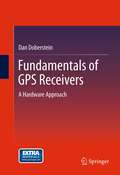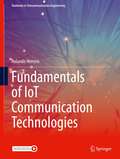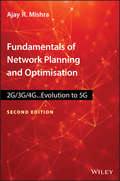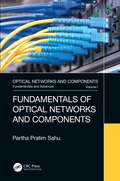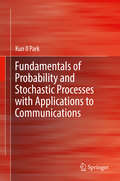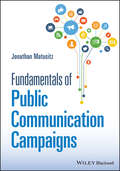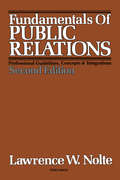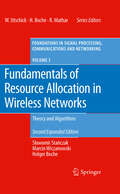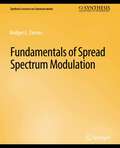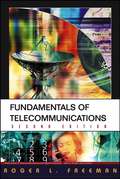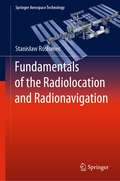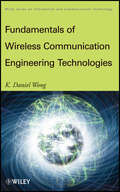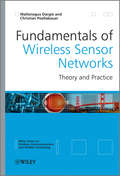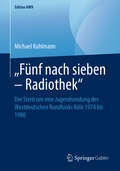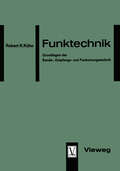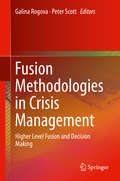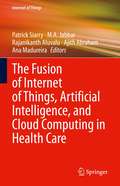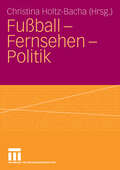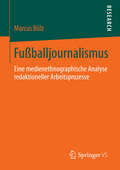- Table View
- List View
Fundamentals of GPS Receivers: A Hardware Approach
by Dan DobersteinFundamentals of GPS receivers covers GPS receivers' theory and practice. The book begins with the basics of GPS receivers and moves onward to more advanced material. The book examines three types of GPS receiver implementations: first is the custom design by the author; second is an industry standard design, now part of the open source network; the third relates to the receiver designed by JPL /NASA. Each receiver is unique allowing the reader to see how each design solves the same problems. Chapters discuss carrier phase measurements and GPS time and frequency measurements. The overall text is measurement oriented as opposed to processing the measurements. With a focus on the fundamentals of measurements the reader will be building their intuition for the physical phenomenon at work.
Fundamentals of IoT Communication Technologies (Textbooks in Telecommunication Engineering)
by Rolando HerreroThis textbook explores all of the protocols and technologies essential to IoT communication mechanisms. Geared towards an upper-undergraduate or graduate level class, the book is presented from a perspective of the standard layered architecture with special focus on protocol interaction and functionality. The IoT protocols are presented and classified based on physical, link, network, transport and session/application layer functionality. The author also lets readers understand the impact of the IoT mechanisms on network and device performance with special emphasis on power consumption and computational complexity. Use cases – provided throughout – provide examples of IoT protocol stacks in action. The book is based on the author’s popular class “Fundamentals of IoT” at Northeastern University. The book includes examples throughout and slides for classroom use. Also included is a 'hands-on’ section where the topics discussed as theoretical content are built as stacks in the context of an IoT network emulator so readers can experiment.
Fundamentals of Network Planning and Optimisation 2G/3G/4G: Evolution to 5G
by Ajay R. MishraUpdated new edition covering all aspects of network planning and optimization This welcome new edition provides comprehensive coverage of all aspects of network planning in all the technologies, from 2G to 5G, in radio, transmission and core aspects. Written by leading experts in the field, it serves as a handbook for anyone engaged in the study, design, deployment and business of cellular networks. It increases basic understanding of the currently deployed, and emerging, technologies, and helps to make evolution plans for future networks. The book also provides an overview of the forthcoming technologies that are expected to make an impact in the future, such as 5G. Fundamentals of Cellular Network Planning and Optimization, Second Edition encompasses all the technologies as well as the planning and implementation details that go with them. It covers 2G (GSM, EGPRS), 3G (WCDMA) and 4G (LTE) networks and introduces 5G. The book also looks at all the sub-systems of the network, focusing on both the practical and theoretical issues. Provides comprehensive coverage of the planning aspects of the full range of today's mobile network systems, covering radio access network, circuit and packet switching, signaling, control, and backhaul/Core transmission networks New elements in book include HSPA, Ethernet, 4G/LTE and 5G Covers areas such as Virtualization, IoT, Artificial Intelligence, Spectrum Management and Cloud By bringing all these concepts under one cover, Fundamentals of Cellular Network Planning and Optimization becomes essential reading for network design engineers working with cellular service vendors or operators, experts/scientists working on end-to-end issues, and undergraduate/post-graduate students.
Fundamentals of Network Planning and Optimisation 2G/3G/4G: Evolution to 5G
by Ajay R. MishraUpdated new edition covering all aspects of network planning and optimization This welcome new edition provides comprehensive coverage of all aspects of network planning in all the technologies, from 2G to 5G, in radio, transmission and core aspects. Written by leading experts in the field, it serves as a handbook for anyone engaged in the study, design, deployment and business of cellular networks. It increases basic understanding of the currently deployed, and emerging, technologies, and helps to make evolution plans for future networks. The book also provides an overview of the forthcoming technologies that are expected to make an impact in the future, such as 5G. Fundamentals of Cellular Network Planning and Optimization, Second Edition encompasses all the technologies as well as the planning and implementation details that go with them. It covers 2G (GSM, EGPRS), 3G (WCDMA) and 4G (LTE) networks and introduces 5G. The book also looks at all the sub-systems of the network, focusing on both the practical and theoretical issues. Provides comprehensive coverage of the planning aspects of the full range of today's mobile network systems, covering radio access network, circuit and packet switching, signaling, control, and backhaul/Core transmission networks New elements in book include HSPA, Ethernet, 4G/LTE and 5G Covers areas such as Virtualization, IoT, Artificial Intelligence, Spectrum Management and Cloud By bringing all these concepts under one cover, Fundamentals of Cellular Network Planning and Optimization becomes essential reading for network design engineers working with cellular service vendors or operators, experts/scientists working on end-to-end issues, and undergraduate/post-graduate students.
Fundamentals of Optical Networks and Components
by Partha Pratim SahuThis book is intended as an undergraduate/postgraduate level textbook for courses on high-speed optical networks as well as computer networks. Nine chapters cover the basic principles of the technology and different devices for optical networks, as well as processing of integrated waveguide devices of optical networks using different technologies. It provides students, researchers and practicing engineers with an expert guide to the fundamental concepts, issues and state-of-the-art developments in optical networks. It includes examples throughout all the chapters of the book to aid understanding of basic problems and solutions. Presents basics of the optical network devices and discusses latest developments Includes examples and exercises throughout all the chapters of the book to aid understanding of basic problems and solutions for undergraduate and postgraduate students Discusses different optical network node architectures and their components Includes basic theories and latest developments of hardware devices with their fabrication technologies (such as optical switch, wavelength router, wavelength division multiplexer/demultiplexer and add/drop multiplexer), helpful for researchers to initiate research on this field and to develop research problem-solving capability Reviews fiber-optic networks without WDM and single-hop and multi-hop WDM optical networks P. P. Sahu received his M.Tech. degree from the Indian Institute of Technology Delhi and his Ph.D. degree in engineering from Jadavpur University, India. In 1991, he joined Haryana State Electronics Development Corporation Limited, where he has been engaged in R&D works related to optical fiber components and telecommunication instruments. In 1996, he joined Northeastern Regional Institute of Science and Technology as a faculty member. At present, he is working as a professor in the Department of Electronics and Communication Engineering, Tezpur Central University, India. His field of interest is integrated optic and electronic circuits, wireless and optical communication, clinical instrumentation, green energy, etc. He has received an INSA teacher award (instituted by the highest academic body Indian National Science Academy) for high level of teaching and research. He has published more than 90 papers in peer-reviewed international journals, 60 papers in international conference, and has written five books published by Springer Nature, McGraw-Hill. Dr Sahu is a Fellow of the Optical Society of India, Life Member of Indian Society for Technical Education and Senior Member of the IEEE.
Fundamentals of Optical Networks and Components
by Partha Pratim SahuThis book is intended as an undergraduate/postgraduate level textbook for courses on high-speed optical networks as well as computer networks. Nine chapters cover the basic principles of the technology and different devices for optical networks, as well as processing of integrated waveguide devices of optical networks using different technologies. It provides students, researchers and practicing engineers with an expert guide to the fundamental concepts, issues and state-of-the-art developments in optical networks. It includes examples throughout all the chapters of the book to aid understanding of basic problems and solutions. Presents basics of the optical network devices and discusses latest developments Includes examples and exercises throughout all the chapters of the book to aid understanding of basic problems and solutions for undergraduate and postgraduate students Discusses different optical network node architectures and their components Includes basic theories and latest developments of hardware devices with their fabrication technologies (such as optical switch, wavelength router, wavelength division multiplexer/demultiplexer and add/drop multiplexer), helpful for researchers to initiate research on this field and to develop research problem-solving capability Reviews fiber-optic networks without WDM and single-hop and multi-hop WDM optical networks P. P. Sahu received his M.Tech. degree from the Indian Institute of Technology Delhi and his Ph.D. degree in engineering from Jadavpur University, India. In 1991, he joined Haryana State Electronics Development Corporation Limited, where he has been engaged in R&D works related to optical fiber components and telecommunication instruments. In 1996, he joined Northeastern Regional Institute of Science and Technology as a faculty member. At present, he is working as a professor in the Department of Electronics and Communication Engineering, Tezpur Central University, India. His field of interest is integrated optic and electronic circuits, wireless and optical communication, clinical instrumentation, green energy, etc. He has received an INSA teacher award (instituted by the highest academic body Indian National Science Academy) for high level of teaching and research. He has published more than 90 papers in peer-reviewed international journals, 60 papers in international conference, and has written five books published by Springer Nature, McGraw-Hill. Dr Sahu is a Fellow of the Optical Society of India, Life Member of Indian Society for Technical Education and Senior Member of the IEEE.
Fundamentals of Probability and Stochastic Processes with Applications to Communications
by Kun Il ParkThis book provides engineers with focused treatment of the mathematics needed to understand probability, random variables, and stochastic processes, which are essential mathematical disciplines used in communications engineering. The author explains the basic concepts of these topics as plainly as possible so that people with no in-depth knowledge of these mathematical topics can better appreciate their applications in real problems. Applications examples are drawn from various areas of communications. If a reader is interested in understanding probability and stochastic processes that are specifically important for communications networks and systems, this book serves his/her need.
Fundamentals of Public Communication Campaigns
by Jonathan MatusitzThe most comprehensive and up-to-date textbook on public communication campaigns currently available Fundamentals of Public Communication Campaigns provides students and practitioners with the theoretical and practical knowledge needed to create and implement effective messaging campaigns for an array of real-world scenarios. Assuming no prior expertise in the subject, this easily accessible textbook clearly describes more than 700 essential concepts of public communication campaigns. Numerous case studies illustrate real-world media campaigns, such as those promoting COVID–19 vaccinations and social distancing, campaigns raising awareness of LGBTQ+ issues, entertainment and Hollywood celebrity campaigns, and social activist initiatives including the #MeToo movement and Black Lives Matter (BLM). Opening with a thorough introduction to the fundamentals of public communication campaigns, the text examines a wide array of different health communication campaigns, social justice and social change campaigns, and counter-radicalization campaigns. Readers learn about the theoretical foundations of public communication campaigns, the roles of persuasion and provocation, how people&’s attitudes can be changed through fear appeals, the use of ethnographic research in designing campaigns, the ethical principles of public communication campaigns, the potential negative effects of public messaging, and much more. Describes each of the 10 steps of public communication campaigns, from defining the topic and setting objectives to developing optimal message content and updating the campaign with timely and relevant information Covers public communication campaigns from the United States as well as 25 other countries, including Australia, Brazil, Canada, China, Egypt, India, Israel, Singapore, South Korea, and the United Kingdom Offers a template for creating or adapting messages for advertising, public relations, health, safety, entertainment, social justice, animal rights, and many other scenarios Incorporates key theories such as the Diffusion of Innovations (DoI) theory, social judgment theory (SJT), the Health Belief Model (HBM), social cognitive theory (SCT), and self–determination theory (SDT) Includes in-depth case studies of communication campaigns of Islamophobia, antisemitism, white supremacism, and violent extremism.Fundamentals of Public Communication Campaigns is the perfect textbook for undergraduate students across the social sciences and the humanities, and a valuable resource for general readers with interest in the subject.
Fundamentals of Public Communication Campaigns
by Jonathan MatusitzThe most comprehensive and up-to-date textbook on public communication campaigns currently available Fundamentals of Public Communication Campaigns provides students and practitioners with the theoretical and practical knowledge needed to create and implement effective messaging campaigns for an array of real-world scenarios. Assuming no prior expertise in the subject, this easily accessible textbook clearly describes more than 700 essential concepts of public communication campaigns. Numerous case studies illustrate real-world media campaigns, such as those promoting COVID–19 vaccinations and social distancing, campaigns raising awareness of LGBTQ+ issues, entertainment and Hollywood celebrity campaigns, and social activist initiatives including the #MeToo movement and Black Lives Matter (BLM). Opening with a thorough introduction to the fundamentals of public communication campaigns, the text examines a wide array of different health communication campaigns, social justice and social change campaigns, and counter-radicalization campaigns. Readers learn about the theoretical foundations of public communication campaigns, the roles of persuasion and provocation, how people&’s attitudes can be changed through fear appeals, the use of ethnographic research in designing campaigns, the ethical principles of public communication campaigns, the potential negative effects of public messaging, and much more. Describes each of the 10 steps of public communication campaigns, from defining the topic and setting objectives to developing optimal message content and updating the campaign with timely and relevant information Covers public communication campaigns from the United States as well as 25 other countries, including Australia, Brazil, Canada, China, Egypt, India, Israel, Singapore, South Korea, and the United Kingdom Offers a template for creating or adapting messages for advertising, public relations, health, safety, entertainment, social justice, animal rights, and many other scenarios Incorporates key theories such as the Diffusion of Innovations (DoI) theory, social judgment theory (SJT), the Health Belief Model (HBM), social cognitive theory (SCT), and self–determination theory (SDT) Includes in-depth case studies of communication campaigns of Islamophobia, antisemitism, white supremacism, and violent extremism.Fundamentals of Public Communication Campaigns is the perfect textbook for undergraduate students across the social sciences and the humanities, and a valuable resource for general readers with interest in the subject.
Fundamentals of Public Relations: Professional Guidelines, Concepts and Integrations
by Lawrence W. NolteFundamentals of Public Relations: Professional Guidelines, Concepts and Integrations, Second Edition focuses on the basic theories and principles involved in the practice of public relations and describes how public relations functions in adapting an organization to its social, political, and economic environment. Practical guidelines for implementing public relations activities are given. This book is comprised of 30 chapters and begins with an assessment of the nature of public relations, including its function and its ecological concept. Historical highlights in the field of public relations are also presented. Subsequent chapters explore five dialogues that emphasize critical problems affecting the practice of public relations: the first covers the role of the chief executive officer in public relations; the second deals with corporate social responsibility; the third shows the attitudes of labor on the question of jobs versus the environment; the fourth reports on problems of protecting the environment; and the fifth takes a searching look at the energy crisis. This monograph is designed to serve as a basic text for students of public relations and those who are in need of a refresher or even an introduction to the subject of public relations.
Fundamentals of Resource Allocation in Wireless Networks: Theory and Algorithms (Foundations in Signal Processing, Communications and Networking #3)
by Slawomir Stanczak Marcin Wiczanowski Holger BocheThe purpose of this book is to provide tools for a better understanding of the fundamental tradeo?s and interdependencies in wireless networks, with the goal of designing resource allocation strategies that exploit these int- dependencies to achieve signi?cant performance gains. Two facts prompted us to write it: First, future wireless applications will require a fundamental understanding of the design principles and control mechanisms in wireless networks. Second, the complexity of the network problems simply precludes the use of engineering common sense alone to identify good solutions, and so mathematics becomes the key avenue to cope with central technical problems in the design of wireless networks. In this book, two ?elds of mathematics play a central role: Perron-Frobenius theory for non-negative matrices and optimization theory. This book is a revised and expanded version of the research monograph “Resource Allocation in Wireless Networks” that was published as Lecture Notes in Computer Sciences (LNCS 4000) in 2006. Although the general structure has remained unchanged to a large extent, the book contains - merous additional results and more detailed discussion. For instance, there is a more extensive treatment of general nonnegative matrices and interf- ence functions that are described by an axiomatic model. Additional material on max-min fairness, proportional fairness, utility-based power control with QoS (quality of service) support and stochastic power control has been added.
Fundamentals of Spread Spectrum Modulation (Synthesis Lectures on Communications)
by Rodger E. ZiemerThis lecture covers the fundamentals of spread spectrum modulation, which can be defined as any modulation technique that requires a transmission bandwidth much greater than the modulating signal bandwidth, independently of the bandwidth of the modulating signal. After reviewing basic digital modulation techniques, the principal forms of spread spectrum modulation are described. One of the most important components of a spread spectrum system is the spreading code, and several types and their characteristics are described. The most essential operation required at the receiver in a spread spectrum system is the code synchronization, which is usually broken down into the operations of acquisition and tracking. Means for performing these operations are discussed next. Finally, the performance of spread spectrum systems is of fundamental interest and the effect of jamming is considered, both without and with the use of forward error correction coding. The presentation ends with consideration of spread spectrum systems in the presence of other users. For more complete treatments of spread spectrum, the reader is referred to [1, 2, 3].
Fundamentals of Telecommunications (Wiley Series in Telecommunications and Signal Processing #92)
by Roger L. FreemanThe Second Edition of this critically-acclaimed text continues the standard of excellence set in the first edition by providing a thorough introduction to the fundamentals of telecommunication networks without bogging you down in complex technical jargon or math. Although focusing on the basics, the book has been thoroughly updated with the latest advances in the field, including a new chapter on metropolitan area networks (MANs) and new sections on Mobile Fi, ZigBee and ultrawideband. You’ll learn which choices are now available to an organization, how to evaluate them and how to develop strategies that achieve the best balance among cost, security and performance factors for voice, data, and image communication.
Fundamentals of the Radiolocation and Radionavigation (Springer Aerospace Technology)
by Stanisław RosłoniecThe book presents principles of operation of radar and radionavigation systems. The group of radar systems includes: primary and secondary radiolocations, bistatic and multistatic systems. They are illustrated with relevant examples of calculation and applications. The issues of increasing the range of the radar systems are presented together with the matched filtering of the used signals. Other discussed issues are methods for eliminating interfering signals and researching methods of 3D space. Various methods of the monopulse radiolocation are presented in Chapter 12. In Chapters 13–18 terrestrial and satellite radionavigation systems are under discussion. The terrestrial systems are: Loran C, Decca Navigator and Omega. The TRANSIT is an example of a hyperbolic satellite system. The stadiometric systems GPS, GLONASS, GALILEO, BeiDou, IRNSS and QZSS are discussed together with differential systems augmentating of them. The ILS, MLS and TLS supporting the landing of aircrafts are discussed in Chapter 17. The prospects for replacing of them with satellite systems augmentated by appropriate reference ground-based stations (GBAS) are also analyzed. Various beacons and ranging devices used in aviation are described in the Chapter 18. This book is intended primarily for students and engineers interested in radar, radionavigation and aerospace engineering.
Fundamentals of Wireless Communication Engineering Technologies (Information and Communication Technology Series, #98)
by K. Daniel WongA broad introduction to the fundamentals of wireless communication engineering technologies Covering both theory and practical topics, Fundamentals of Wireless Communication Engineering Technologies offers a sound survey of the major industry-relevant aspects of wireless communication engineering technologies. Divided into four main sections, the book examines RF, antennas, and propagation; wireless access technologies; network and service architectures; and other topics, such as network management and security, policies and regulations, and facilities infrastructure. Helpful cross-references are placed throughout the text, offering additional information where needed. The book provides: Coverage that is closely aligned to the IEEE's Wireless Communication Engineering Technologies (WCET) certification program syllabus, reflecting the author's direct involvement in the development of the program A special emphasis on wireless cellular and wireless LAN systems An excellent foundation for expanding existing knowledge in the wireless field by covering industry-relevant aspects of wireless communication Information on how common theories are applied in real-world wireless systems With a holistic and well-organized overview of wireless communications, Fundamentals of Wireless Communication Engineering Technologies is an invaluable resource for anyone interested in taking the WCET exam, as well as practicing engineers, professors, and students seeking to increase their knowledge of wireless communication engineering technologies.
Fundamentals of Wireless Communication Engineering Technologies (Information and Communication Technology Series, #98)
by K. Daniel WongA broad introduction to the fundamentals of wireless communication engineering technologies Covering both theory and practical topics, Fundamentals of Wireless Communication Engineering Technologies offers a sound survey of the major industry-relevant aspects of wireless communication engineering technologies. Divided into four main sections, the book examines RF, antennas, and propagation; wireless access technologies; network and service architectures; and other topics, such as network management and security, policies and regulations, and facilities infrastructure. Helpful cross-references are placed throughout the text, offering additional information where needed. The book provides: Coverage that is closely aligned to the IEEE's Wireless Communication Engineering Technologies (WCET) certification program syllabus, reflecting the author's direct involvement in the development of the program A special emphasis on wireless cellular and wireless LAN systems An excellent foundation for expanding existing knowledge in the wireless field by covering industry-relevant aspects of wireless communication Information on how common theories are applied in real-world wireless systems With a holistic and well-organized overview of wireless communications, Fundamentals of Wireless Communication Engineering Technologies is an invaluable resource for anyone interested in taking the WCET exam, as well as practicing engineers, professors, and students seeking to increase their knowledge of wireless communication engineering technologies.
Fundamentals of Wireless Sensor Networks: Theory and Practice (Wireless Communications And Mobile Computing Ser. #19)
by Waltenegus Dargie Christian PoellabauerIn this book, the authors describe the fundamental concepts and practical aspects of wireless sensor networks. The book provides a comprehensive view to this rapidly evolving field, including its many novel applications, ranging from protecting civil infrastructure to pervasive health monitoring. Using detailed examples and illustrations, this book provides an inside track on the current state of the technology. The book is divided into three parts. In Part I, several node architectures, applications and operating systems are discussed. In Part II, the basic architectural frameworks, including the key building blocks required for constructing large-scale, energy-efficient sensor networks are presented. In Part III, the challenges and approaches pertaining to local and global management strategies are presented – this includes topics on power management, sensor node localization, time synchronization, and security. At the end of each chapter, the authors provide practical exercises to help students strengthen their grip on the subject. There are more than 200 exercises altogether. Key Features: Offers a comprehensive introduction to the theoretical and practical concepts pertaining to wireless sensor networks Explains the constraints and challenges of wireless sensor network design; and discusses the most promising solutions Provides an in-depth treatment of the most critical technologies for sensor network communications, power management, security, and programming Reviews the latest research results in sensor network design, and demonstrates how the individual components fit together to build complex sensing systems for a variety of application scenarios Includes an accompanying website containing solutions to exercises (http://www.wiley.com/go/dargie_fundamentals) This book serves as an introductory text to the field of wireless sensor networks at both graduate and advanced undergraduate level, but it will also appeal to researchers and practitioners wishing to learn about sensor network technologies and their application areas, including environmental monitoring, protection of civil infrastructure, health care, precision agriculture, traffic control, and homeland security.
Fundamentals of Wireless Sensor Networks: Theory and Practice (Wireless Communications and Mobile Computing #19)
by Waltenegus Dargie Christian PoellabauerIn this book, the authors describe the fundamental concepts and practical aspects of wireless sensor networks. The book provides a comprehensive view to this rapidly evolving field, including its many novel applications, ranging from protecting civil infrastructure to pervasive health monitoring. Using detailed examples and illustrations, this book provides an inside track on the current state of the technology. The book is divided into three parts. In Part I, several node architectures, applications and operating systems are discussed. In Part II, the basic architectural frameworks, including the key building blocks required for constructing large-scale, energy-efficient sensor networks are presented. In Part III, the challenges and approaches pertaining to local and global management strategies are presented – this includes topics on power management, sensor node localization, time synchronization, and security. At the end of each chapter, the authors provide practical exercises to help students strengthen their grip on the subject. There are more than 200 exercises altogether. Key Features: Offers a comprehensive introduction to the theoretical and practical concepts pertaining to wireless sensor networks Explains the constraints and challenges of wireless sensor network design; and discusses the most promising solutions Provides an in-depth treatment of the most critical technologies for sensor network communications, power management, security, and programming Reviews the latest research results in sensor network design, and demonstrates how the individual components fit together to build complex sensing systems for a variety of application scenarios Includes an accompanying website containing solutions to exercises (http://www.wiley.com/go/dargie_fundamentals) This book serves as an introductory text to the field of wireless sensor networks at both graduate and advanced undergraduate level, but it will also appeal to researchers and practitioners wishing to learn about sensor network technologies and their application areas, including environmental monitoring, protection of civil infrastructure, health care, precision agriculture, traffic control, and homeland security.
„Fünf nach sieben – Radiothek“: Der Streit um eine Jugendsendung des Westdeutschen Rundfunks Köln 1974 bis 1980 (Edition KWV)
by Michael KuhlmannOb SWF-Popshop, BR-Zündfunk oder ZDF-Direkt: Jugendsendungen der 1970er Jahre ecken an. Den größten Wirbel macht die Radiothek des WDR. „Rot unterwandert“ nennen sie die einen. Für die anderen ist sie das Radio der Zukunft: frech und basisdemokratisch. Mit Moderatoren wie Dave Colman, Winfried Trenkler oder Mal Sondock. Jeder zweite Jugendliche in Nordrhein-Westfalen hört sie 1976 regelmäßig. Die Radiothek bringt Pop und Politik, Rock und Reportagen – in der Sprache der Jugendlichen. Über Arbeitskämpfe und Aussteiger, über Kriegsdienstverweigerer und Paragraph 218. Politiker, katholische Kirche und Arbeitgeber laufen dagegen Sturm. Als RAF-Terror, Hausbesetzungen und Anti-AKW-Demos die Republik aufwühlen, droht auch der Streit um die Radiothek zu eskalieren.Dieses Buch handelt von der wohl umstrittensten Sendereihe der deutschen Radiogeschichte. Für Leute, die mehr wissen wollen über Politik und Jugendkultur der wilden 70er Jahre.
Funktechnik: Grundlagen der Sende-, Empfangs- und Funkortungstechnik
by Robert Richard KühnDas vorliegende Buch wurde für die Ausbildung des Funkpersonals und der Funk techniker in der kommerziellen Technik und in anderen Fachgebieten außerhalb der Unterhaltungstechnik geschrieben. Besonderer Wert wurde auf die Erarbeitung der Grundlagen gelegt, auf die heute weniger denn je verzichtet werden kann. Es wird jedoch vorausgesetzt, daß der Leser mit den einfachen Grundgesetzen der Elektrotechnik bereits vertraut ist. Unter weitgehendem Verzicht auf mathematische Hilfsmittel werden alle z. Z. in der Funktechnik angewendeten Prinzipien erläutert, sofern deren Kennmis für die Praxis nützlich erschien. Unter anderem wird gezeigt, daß sich die Vielfalt der physikalischen Vorgänge auf verhälmismäßig wenig grundsätzliche Erscheinungen zurückführen läßt, die überall in der Elektrotechnik zu finden sind. Neben der Vermittlung der Grundlagen werden viele praktische Hinweise fur das Arbeiten mit Funkanlagen gegeben. Diese Teile des Buches werden auch von dem bereits in der Praxis stehenden Funk personal mit Gewinn gelesen werden, zumal die neuesten Erkenntnisse und Er fahrungen ausgewertet wurden. In einer weiteren Veröffentlichung sollen gerätekundliehe Themen behandelt werden.
Fusion Methodologies in Crisis Management: Higher Level Fusion and Decision Making
by Galina Rogova Peter ScottThe book emphasizes a contemporary view on the role of higher level fusion in designing crisis management systems, and provide the formal foundations, architecture and implementation strategies required for building dynamic current and future situational pictures, challenges of, and the state of the art computational approaches to designing such processes. This book integrates recent advances in decision theory with those in fusion methodology to define an end-to-end framework for decision support in crisis management. The text discusses modern fusion and decision support methods for dealing with heterogeneous and often unreliable, low fidelity, contradictory, and redundant data and information, as well as rare, unknown, unconventional or even unimaginable critical situations. Also the book examines the role of context in situation management, cognitive aspects of decision making and situation management, approaches to domain representation, visualization, as well as the role and exploitation of the social media. The editors include examples and case studies from the field of disaster management.
The Fusion of Internet of Things, Artificial Intelligence, and Cloud Computing in Health Care (Internet of Things)
by Patrick Siarry M. A. Jabbar Rajanikanth Aluvalu Ajith Abraham Ana MadureiraThis book reviews the convergence technologies like cloud computing, artificial intelligence (AI) and Internet of Things (IoT) in healthcare and how they can help all stakeholders in the healthcare sector. The book is a proficient guide on the relationship between AI, IoT and healthcare and gives examples into how IoT is changing all aspects of the healthcare industry. Topics include remote patient monitoring, the telemedicine ecosystem, pattern imaging analytics using AI, disease identification and diagnosis using AI, robotic surgery, prediction of epidemic outbreaks, and more. The contributors include applications and case studies across all areas of computational intelligence in healthcare data. The authors also include workflow in IoT-enabled healthcare technologies and explore privacy and security issues in healthcare-based IoT.
Fußball - Fernsehen - Politik
by Christina Holtz-BachaDieses Buch nimmt die Weltmeisterschaft in Deutschland zum Anlass, die Beziehungen im Dreieck von Fußball - Fernsehen - Politik genauer zu beleuchten. Die Beiträge untersuchen u. a. den Fußball als Gegenstand medienpolitischer Kontroversen, die Rolle des Fußballs im Fernsehen und für das Fernsehen, die Integrationsfunktion von internationalen Fußballwettbewerben, Fußballer als "Journalisten", den Einfluss von Erfolgen der Nationalelf auf die (politische) Stimmung der Wählerschaft sowie Fußballer in der Rolle von Prominenten.
Fußballgroßveranstaltungen im Spannungsverhältnis zwischen Freiheit und Sicherheit: Eine wissenschaftliche Untersuchung zur Bedeutung von Kommunikation und Dialog
by Thomas Kubera Dieter KugelmannDas Buch präsentiert die wissenschaftlichen Ergebnisse des interdisziplinären Forschungsprojektes „Mehr Sicherheit im Fußball – Verbessern der Kommunikationsstrukturen und Optimieren des Fandialogs“. Die aus dem vom Bundesministerium für Bildung und Forschung geförderten Projekt hervorgehenden Erkenntnisse zum Status Quo der Sicherheitsgewährleistung bei Fußballgroßveranstaltungen bieten eine Reihe von Ansätzen zur Verbesserung von Kommunikationsstrukturen und -prozessen. Sie basieren auf Untersuchungen an 25 Vereinsstandorten der ersten drei Profiligen. Das Feld wurde durch Interviews mit Experten aus Fanarbeit, Fanszenen, Polizeibehörden, Vereinen und Kommunen und durch Befragungen von Stadionbesuchern, Fangruppierungen, Reisenden im Fanreiseverkehr und der Bevölkerung erschlossen. Weiterhin wurden rechtliche Stellungnahmen und Empfehlungen erarbeitet sowie eine technische Kommunikationsplattform beforscht, die eine effektive Zusammenarbeit der verschiedenen Akteure ermöglichen soll.
Fußballjournalismus: Eine medienethnographische Analyse redaktioneller Arbeitsprozesse
by Marcus BölzDas Phänomen Fußball produziert mit seinen schnell wechselnden Ereignissen und Idolen fortwährenden Diskussionsstoff und verfügt über das Potenzial, Menschen über alle soziale Schichten hinweg zu faszinieren. Fußball erzählt heute globale Geschichten und inszeniert sich auf allen Kanälen als mediales Spektakel, dem (fast) keiner entkommen kann. Marcus Bölz untersucht vor dem Hintergrund der zunehmenden Professionalisierung und Kommerzialisierung des Fußballbetriebs, wie sich die Arbeit und die Selbstwahrnehmung von Sportjournalisten verändert haben. Anhand einer redaktionellen Arbeitsprozessanalyse untersucht er die zahlreichen Maxime und Praktiken deutscher Fußballjournalisten und konfrontiert Spieler, Trainer und Fans mit den Ergebnissen. Er zeigt, dass diese von der Kultur der Fußballberichterstattung teilweise eine ganz andere Vorstellung haben als die untersuchten und befragten Journalisten.
